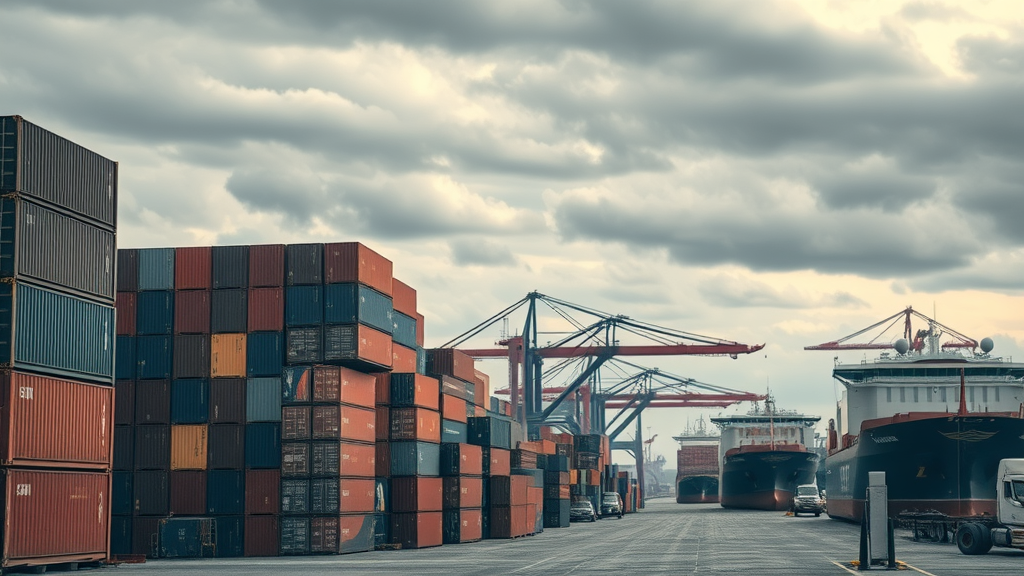Did you know that improper classification of goods results in thousands of dollars in unnecessary import duties each year? Discover how to avoid these costly mistakes when it comes to import duties US regulations.

Are you importing products into the United States? If so, every oversight could cost your business. With changing customs duty laws, intricate tariff schedules, and frequent country of origin errors, US importers face hidden risks that can lead to expensive setbacks. According to US Customs & Border Protection, thousands of companies pay more than they should every year—simply because they misunderstood the rules. In this guide, you’ll learn expert strategies to avoid costly missteps, optimize your import process, and stay compliant with every regulation concerning import duties US .
- How to determine the right customs duty and duty rate for your products
- Leveraging harmonized tariff code (HTS code) and understanding the impact of country of origin
- Reducing your import tax using trade agreements
- Tactics to avoid costly mistakes, delays, and penalties at the border
- Best practices for working with a customs broker
"Navigating the complexities of United States customs clearance is essential to avoid import duty surprises."

Understanding Import Duties US: Key Concepts and Why They Matter
Import duties US are a fundamental cost for anyone moving goods into the United States, and understanding the nuances can mean substantial savings. Customs duty is a tax, set by the US government, applied to imported products. These taxes help regulate international trade, protect local industries, and generate federal revenue. Every importer should understand how these customs duties are determined and why correct assessment is vital to business competitiveness and compliance.
The import duty and import tax you pay are determined by several factors—a combination of product classification, value, country of origin, and current tariff schedules . The US authorities, primarily Customs and Border Protection (CBP), enforce strict rules: even small mistakes (such as incorrect HTS code or misreporting country of origin ) can make shipments subject to higher duty rates or cause significant delays.
Understanding duty rate variations is fundamental. Rates vary by product, origin, and are subject to shifts in US trade agreements and international policy. Navigating the intricate customs clearance process means knowing the documentation required and ensuring accuracy at every step – from initial paperwork to final payment of import duties US .
What You’ll Learn in This Comprehensive Import Duties US Guide
- How to determine customs duty and import duty rates
- Ways to use trade agreements and tariff schedules to reduce costs
- The impact of harmonized tariff schedule (HTS code) and country of origin
- How to leverage customs brokers , border protection , and official customs resources
- How to calculate your import tax, duty rates , and avoid common pitfalls
"Customs duties are not just another fee—they’re an essential cost factor for every US importer."
Customs Duty and Import Duty Rates: The Core of Import Duties US
What Are US Customs Duty, Import Duty, and Import Tax?
US customs duty , import duty , and import tax can be confusing, as these terms are often used interchangeably but have specific meanings. Customs duty and import duty refer to taxes placed on imported goods by the United States government. These duties are based on a commodity's classification under the harmonized tariff schedule (HTS code), its declared value, and its country of origin .
The distinction between import tax and sales tax is also crucial. Import tax is paid at the border and calculated as a percentage of the goods' value, whereas sales tax is collected at the point of sale within the United States. Enforcement of these duties is managed by Customs and Border Protection. These agencies ensure importers comply with every rule and regulation, flagging errors for additional review or penalties. Accurate classification and valuation are the importer's responsibility—mistakes can result in steep financial consequences.
- Customs duty vs. Import duty vs. Import tax vs. Sales tax: Customs duty and import duty are both tariffs on imports; import tax encompasses all such taxes; sales tax is separate, applicable on domestically sold goods.
- The role of US Customs and Border Protection: This federal agency enforces the collection of customs duties US , investigates errors, and manages border security for international trade.

How Are Duty Rates Determined? Understanding the Tariff Schedule
Duty rates in the United States are primarily determined by consulting the Harmonized Tariff Schedule (HTS), a highly detailed product classification system. Each import is assigned an HTS code reflecting its nature and intended use, which in turn determines its applicable duty rate . This comprehensive tariff schedule is regularly updated, incorporating everything from electronics and textiles to chemicals and food.
The country of origin and the correct assignment of the HTS code affect your import duty . Trade agreements—like NAFTA, USMCA, or GSP—can reduce or eliminate duties for qualifying goods. It’s crucial to use the most current tariff schedule from the official gov website and confirm the product’s journey matches United States rules for origin documentation.
| Product Category | Country of Origin | HTS Code | Duty Rate | Potential Free Trade Agreement Benefit |
|---|---|---|---|---|
| Textiles | China | 6203.42.40 | 16.5% | No |
| Automotive Parts | Mexico | 8708.29.29 | 2.5% | Yes (USMCA) |
| Consumer Electronics | Japan | 8517.12.00 | 0% | No |
| Handbags | Vietnam | 4202.22.15 | 10% | No |
Import Duties US: Navigating Customs Clearance and Border Protection
Step-by-Step Review of the Customs Clearance Process
The customs clearance process in the United States is rigorous—each step is essential to ensure your goods are admitted and taxed appropriately. First, you must submit an entry package including your customs entry, the commercial invoice, and a detailed packing list. These documents should match your HTS code and accurately reflect the country of origin , quantities, and value of the goods.
Your customs broker plays a crucial role in this process. They prepare necessary declarations and correspond with Customs and Border Protection (CBP) on your behalf, helping you avoid errors that could trigger further scrutiny or penalties. When you interact with CBP officials, transparency is key. Ensure you provide all requested documentation and clarify any ambiguities proactively—mistakes in customs clearance may delay your shipment or increase your financial obligation.
- Essential Documents: Customs entry, commercial invoice, packing list (must match HTS code and values declared)
- Importance of Customs Brokers: Most importers benefit from using a licensed broker knowledgeable in tariff schedules, free trade agreement eligibility, and duty rates
- Interacting with CBP: Provide accurate, up-to-date information—honesty prevents costly delays or penalties
Common Mistakes that Trigger Additional Customs Duties and Delays
One of the most expensive mistakes US importers make is improper classification using the harmonized tariff code (HTS code). Assigning the wrong code results in either overpaying or facing penalties after audits reveal discrepancies. Even minor clerical errors can trigger unnecessary customs duties and substantial delays at the border.
Another frequent pitfall is failing to verify the country of origin —particularly important for goods eligible for reduced rates under a free trade agreement. Inaccurate declarations or missing documentation can void your eligibility and lead to retroactive duty collection at higher rates. Also, correctly declaring your goods’ value and using the appropriate duty rate is non-negotiable; mistakes in valuation can result in interest charges and additional customs fees.
- Improper classification under the harmonized tariff code (HTS code)
- Neglecting to double-check the country of origin (essential for free trade and lower duty rates)
- Errors when declaring imported goods’ value or applying the wrong duty rate
"A single mistake in your customs declaration can lead to significant penalties or increased duty rates."

Leveraging Trade Agreements to Reduce Import Duties US
How Free Trade Agreements and Other Trade Agreements Impact Duty Rates
Free trade agreements (FTAs) and other trade agreements are powerful tools for reducing your import duty and customs duties US . The United States has negotiated several agreements that allow for reduced or even zero tariff rates on imports that meet strict eligibility criteria. Using these agreements, such as USMCA (formerly NAFTA), CAFTA-DR, or the Generalized System of Preferences (GSP), requires detailed knowledge of the correct tariff schedule and compliant documentation.
Each trade agreement comes with its own set of rules regarding product eligibility, required certifications, and proof of country of origin . Staying updated via official government agencies or a licensed customs broker is crucial, as failure to comply can mean retroactive duty charges or loss of preferential rates.
| Agreement | Eligible Countries | Products Covered | Potential Duty Savings | Required Documentation |
|---|---|---|---|---|
| USMCA | US, Mexico, Canada | Automotive, Agriculture, Textiles, etc. | 0-100% Reduction | Certificate of Origin |
| GSP | Developing Nations (varies) | Many industrial and consumer goods | Up to 100% | Origin Statement |
| CAFTA-DR | Central America, DR | Textiles, Food, Industrial Goods | 0-85% | Manufacturer's Affidavit |
Applying for Duty-Free Status and Managing Country of Origin Rules
Securing duty-free status under a free trade agreement is not automatic. You must provide all required documentation, such as certificates of origin or detailed manufacturing affidavits, proving your goods meet the agreement criteria. Meticulous record-keeping is critical—officials will audit eligibility periodically, and improper documentation can result in large, retroactive import duty assessments.
The country of origin rules are especially significant for products sourced or processed in multiple locations. Goods not meeting the substantial transformation or value-added thresholds won’t qualify for special rates, even if partially manufactured in an eligible country. Consulting the latest guidance from the Customs and Border Protection or working with an experienced customs broker ensures you don’t miss these important details.
- Documentation required: Certificates of origin, manufacturing affidavits, and supporting evidence
- Proving country of origin: Ensure all sourcing, manufacturing, and assembly records are prepared and accessible for customs review

Calculating and Planning for Import Duties US and Import Tax Expenses
Methods for Calculating Import Duty, Customs Duty, and Import Tax
Calculating your import duty and customs duties US before shipping is essential for financial planning. Start by identifying the correct HTS code for your product using the Harmonized Tariff Schedule. This code tells you the applicable duty rate . Next, confirm the product's country of origin , which affects eligibility for reduced rates under a relevant trade agreement . Finally, use an online customs duty calculator or refer to the gov website for official rates.
For example, importing a pair of shoes (HTS 6403.99.90) from Vietnam currently incurs a 12.5% duty rate , but the same product from Canada under USMCA might be duty-free with proper documentation. Import tax can be substantial, so always verify your cost structure using official sources and review your numbers for accuracy before submitting customs entry documents. Misclassifying products or using outdated tariff rates can make a big dent in your bottom line.
- Use official customs duty calculators and regularly updated tariff schedules
- Always reference authoritative websites (like the CBP and US International Trade Commission official website)
- Check examples relevant to your sector and origin country for clarity

How to Seamlessly Budget for Customs Duties in the United States
Budgeting for customs duties should be an integral part of your import process. Beyond the primary import duty , factor in other costs like sales tax where applicable, brokerage fees charged by your customs broker , and potential warehousing expenses. To prevent financial shocks, monitor updates from Customs and Border Protection and stay aware of global trade developments affecting tariff rates and duty rates.
Major importers often set up internal controls to promptly track changes in tariff schedules , trade agreements, and CBP rulings. Proactive budgeting allows you to factor in all ancillary expenses, ensuring you remain profitable even when customs duties or import duties fluctuate suddenly.
- Factor in sales tax , brokerage, warehousing, and transit costs
- Monitor official Customs and Border Protection updates regularly
"Proactive budgeting for customs clearance and duty rates prevents unexpected cost overruns."

Best Practices: Minimizing Import Duties US with Experienced Customs Brokers
- Choosing the right customs broker ensures your import documentation and HTS codes are accurate
- Leverage brokers’ expertise to optimize product classification and get the best available duty rate
- Experienced agents help you avoid common compliance pitfalls in customs and border processes
Advanced Strategies for Major Importers: Duty Drawback, Warehousing, and More
Larger importers can benefit from duty drawback programs, which refund customs duties on re-exported goods. Eligibility depends on proper recordkeeping and filing through approved customs brokers or directly via the official government website. Another advanced strategy is using bonded warehousing to defer paying import duty until your goods are released to the US market—improving cash flow and streamlining compliance.
Strict compliance with United States customs and border protection regulations is essential—CBP audits can retroactively assess duties or penalties. Regular training for staff, periodic internal audits, and ongoing consulting with customs professionals are strongly recommended for major importers who want to avoid surprises and maximize their cost efficiency.
- Duty drawback programs are an option for exporters—ask your customs broker if you qualify
- Bonded warehouses allow you to defer customs duties until goods are withdrawn for US use
- Stay compliant with all customs and border protection rules
People Also Ask: Key Questions on Import Duties US

How much is import duty to the US?
- Import duty varies by product type, value, and origin—most manufactured goods fall between 0% and 25%, with an average rate around 5.5% to 7.5% for general consumer items. Specialty products, textiles, and agricultural goods may have much higher duty rates. Always use an official calculator based on your HTS code for precise costs.
Who pays US import duties?
- By US law, the importer of record—usually the purchasing business or individual noted on the customs entry documentation—is responsible for paying all import duties, customs duties, and import tax prior to customs clearance and the goods’ release.
How to calculate import duties?
- Calculate import duties by properly classifying your goods with the accurate HTS code, determining the correct duty rate from the tariff schedule, confirming country of origin eligibility, and multiplying the declared customs value by the applicable rate. Consider using customs duty calculators or consulting your customs broker for accuracy.
What is the duty-free limit for US customs?
- The US “personal exemption” allows individual travelers to import goods duty-free up to $800 (as of 2024). For business imports, most low-value shipments under $800 (using Section 321 Entry Type) may also qualify for exemption, but restrictions and product exclusions apply. Check updated guidelines on the US Customs and Border Protection official website for details.
Frequently Asked Questions about Import Duties US
-
What is the difference between import duty and import tax in the United States?
Import duty generally refers to taxes levied on specific imported goods, while import tax can refer to both customs duty and broader taxes that might apply, such as excise or other border-imposed taxes. -
How does country of origin affect US customs duty?
The country of origin impacts your product’s duty rate eligibility under trade agreements. Goods from countries with a free trade agreement may receive preferential or zero duties if qualifying rules are met. -
Are there penalties for misclassifying goods under HTS codes?
Yes, misclassification can result in financial penalties, shipment delays, and possible seizure by Customs and Border Protection. Always verify codes using the latest tariff schedule. -
How often do import duty and customs duties rates change?
Duty rates can change frequently as trade agreements or tariff schedules are updated. Always check the official gov website or consult a customs broker before importing. -
Do I always need a customs broker for US imports?
No, but using a licensed broker reduces your risk of errors, ensures timely processing, and often saves costs by optimizing tariff codes and compliance.
"Staying ahead of changes in import duties US ensures that your business remains competitive and compliant."
Key Strategies to Avoid Costly Surprises with Import Duties US
- Monitor new trade agreements and tariff schedules for favorable duty rates
- Consult expert customs brokers before every major shipment
- Regularly update and audit your product classifications (HTS codes)
- Set up alerts for Customs and Border Protection policy changes and tariff rate updates

Take Action: Tap into Global Trade Insights With RP Design Web Services
- Got Something to Say About Global Trade? RP Design Web Services can put your insights on Global Trade Notes in front of the right audience. Call 203-271-7991 today and get your word out.
Pro tip: Always cross-check current duty rates and trade policies before importing—staying informed is your best defense against costly surprises in import duties US.
Importing goods into the United States involves navigating a complex landscape of duties, taxes, and regulations. To avoid costly surprises, it’s essential to understand the various components that contribute to import costs and compliance requirements.
Understanding Import Duties and Taxes
Import duties, also known as tariffs, are taxes imposed by the U.S. government on imported goods. These duties are calculated based on the product’s classification under the Harmonized Tariff Schedule (HTS), its value, and country of origin. Duty rates can vary significantly, typically ranging from 0% to 37.5%, with an average rate around 5.63%. ( cargos.com )
In addition to import duties, other fees may apply:
-
Merchandise Processing Fee (MPF): Charged by U.S. Customs and Border Protection (CBP) for processing import paperwork. For formal entries (goods valued over $2,500), the fee is 0.3464% of the value, with a minimum of $27.23 and a maximum of $528.33. ( importal.com )
-
Harbor Maintenance Fee (HMF): Assessed on imports arriving by sea, typically 0.125% of the cargo’s value. ( importal.com )
-
Federal Excise Tax: Imposed on specific imports like alcoholic beverages and tobacco products. ( cargos.com )
Determining the Correct HTS Code
Accurate classification of goods using the HTS is crucial, as it determines the applicable duty rate. The HTS classifies products based on their name, use, and material composition, assigning a ten-digit code. Misclassification can lead to overpayment of duties or penalties. ( en.wikipedia.org )
Leveraging Trade Agreements
The U.S. has Free Trade Agreements (FTAs) with various countries, which can reduce or eliminate duties on qualifying goods. To benefit, importers must ensure their products meet the “originating” criteria specified in each FTA and provide the necessary documentation, such as a Certificate of Origin. ( cargos.com )
Calculating Import Duties
To estimate import duties:
-
Identify the HTS Code: Determine the correct code for your product.
-
Determine the Duty Rate: Find the applicable rate associated with the HTS code.
-
Calculate the Duty: Multiply the product’s value by the duty rate.
For example, importing goods valued at $10,000 with a duty rate of 2% would result in a $200 duty. ( usacustomsclearance.com )
Avoiding Common Pitfalls
Common mistakes that can lead to unexpected costs include:
-
Misclassification of Goods: Using an incorrect HTS code can result in incorrect duty rates.
-
Incorrect Valuation: Underreporting or overreporting the value of goods can lead to penalties.
-
Ignoring Trade Agreements: Failing to utilize applicable FTAs can result in paying higher duties than necessary.
Staying Informed on Regulatory Changes
Trade policies and tariff rates can change due to new legislation or international agreements. For instance, recent developments include:
-
Tariff Truce Extension: The U.S. and China extended their tariff truce by 90 days, maintaining current tariff levels and avoiding significant increases. ( reuters.com )
-
Budget Deficit and Tariff Revenue: Despite a surge in customs revenue from increased tariffs, the U.S. budget deficit grew by 19% year-over-year in July 2025. ( reuters.com )
Best Practices
-
Consult with Experts: Engage licensed customs brokers to navigate complex regulations and ensure compliance.
-
Utilize Official Resources: Refer to the U.S. International Trade Commission and CBP for the latest information on tariffs and import requirements.
-
Stay Updated: Regularly monitor changes in trade policies and tariff schedules to adapt your import strategies accordingly.
By understanding and proactively managing these aspects of the import process, businesses can minimize unexpected costs and ensure smooth operations when importing into the United States.
 Add Row
Add Row  Add
Add 




Write A Comment